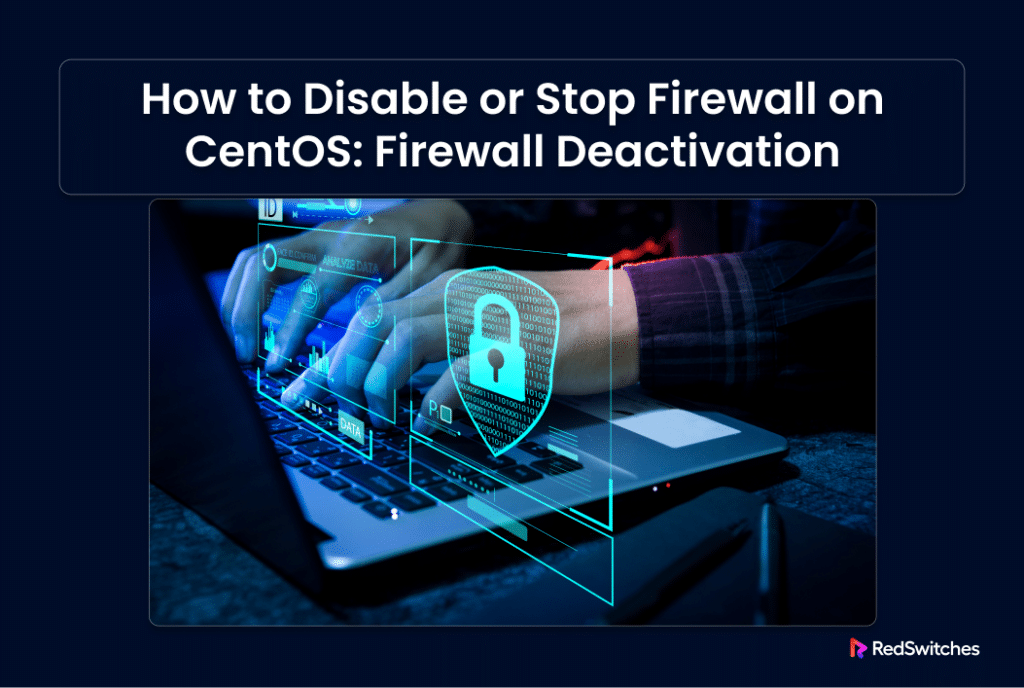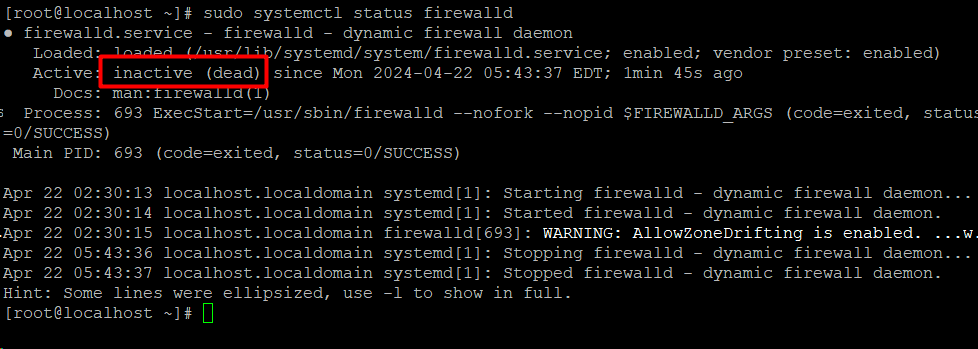firewalld is a dynamic firewall management tool designed to manage incoming and outgoing traffic dynamically.
It offers dynamic configuration, zone-based rules, and integration with network management tools.
firewalld is often the default firewall management tool in CentOS 7. Unlike its predecessor, iptables, firewalld offers a more user-friendly and dynamic approach to managing firewall rules.
Though it is not recommended to disable firewalld, there are times when troubleshooting specific issues calls for disabling it.
In this comprehensive tutorial, we will discuss the process of turning off firewalld in a CentOS 7 environment. However, we will first start with a quick look at the benefits of the firewall.
Table Of Content
The Benefits of firewalld
Before understanding how to disable firewalld, let us understand some of the features of firewalld.
Strong Network Security Features
firewalld offers robust security features that guard against malicious activity and unapproved access.
Ease of Use
firewalld makes managing firewall rules easier with its user-friendly interface and simple instructions.
Dynamic Updates
You can update (or downgrade) the core firewalld package and change firewall rules without affecting network access.
Better Network Filtering
It offers enhanced traffic control, scalable rule sets, and effective network packet filtering,
Centralized Management
firewalld‘s ability to provide centralized management of firewall configurations simplifies security policy implementation and maintenance, especially in multi-node setups.
How to Disable firewalld in CentOS 7
Let’s start going into the details of the process of disabling firewalld in CentOS 7.
The Prerequisites
Before diving in, ensure you have the following:
- A system running a stable version of CentOS 7
- A user account with administrative and sudo access
- You have firewalld installed on the system
Step #1: Verify the Current firewalld Status
On almost every CentOS 7 system, firewalld is turned on by default. However, you should not assume this and verify the firewall status.
For this, run the following command:
# sudo systemctl status firewalld
If the firewalld is active, a bright green output Active: active (running), similar to the following screenshot, will be displayed.
Step #2: Disable firewalld
The firewalld can be disabled permanently or temporarily.
Disable firewalld Temporarily
Run the following command to disable CentOS 7’s built-in firewalld manager temporarily:
# sudo systemctl stop firewalld
Note: You won’t receive a confirmation message about the success of the command.
That’s why you need to confirm the firewalld is turned off. For this, run this command:
# sudo systemctl status firewalld
If the output is Active: inactive (dead), the firewalld is turned off.
Note that the systemctl stop firewalld command disables the service until the next reboot. Once the current session ends and the system reboots, the firewalld service will be active again.
Disable firewalld Permanently
To permanently disable the firewalld on CentOS 7, you must first disable the firewall service and then disable it altogether.
Start by running the following command to disable the firewall:
# sudo systemctl stop firewalld
This command disables firewalld temporarily.
Next, verify the firewall status by running this command:
# sudo systemctl status firewalld
If the output is Active: inactive (dead), the firewalld is turned off.
Now, execute the second phase of the process. Here, we will disable the service so that it doesn’t start when the system boots up.
We recommend running the following command:
# sudo systemctl disable firewalld
Though you have disabled and halted the firewalld service on your CentOS 7 server, other running processes may activate firewalld. To prevent this, firewalld should be hidden from other system services.
Run the following command to hide the firewalld from the active systems:
# sudo systemctl mask --now firewalld
This creates a symbolic link (symlink) to /dev/null for the firewalld service.
The output would be:
Output
Created symlink from /etc/systemd/system/firewalld.service to /dev/null.
Conclusion
This post outlines the simple process you can use to disable or turn off firewalld on CentOS 7. By following the instructions, users can temporarily or permanently disable the firewalld to suit their own needs. Keep in mind that disabling firewalld will remove the system’s default security layer and could expose it to security risks. Consequently, when disabling firewalld, proceeding cautiously and considering other security measures is advised. To keep their system environment safe, users should re-enable firewalld as needed.
Considering the importance of maintaining a secure computing environment, exploring alternative security measures is crucial if firewalld on CentOS 7 needs to be disabled.
At RedSwitches, we prioritize your hosting needs globally. We have a long list of customizable bare metal servers and a high reputation, thanks to decade-long roots in the industry. Our latest line of servers come with Intel and AMD CPUs, instant delivery, and live 24/7 expert support.
Contact us today to help secure your business and meet your security requirements.
FAQs
Q. Why would I want to disable firewalld on CentOS 7?
firewalld needs to be disabled in cases, such as utilizing alternate firewall solutions or debugging network connectivity issues.
Q. Is it safe to disable firewalld on CentOS 7?
By turning off firewalld, you can expose the system to security vulnerabilities by removing the firewall’s default protection. It should only be done cautiously and under expert supervision.
Q. How can I disable firewalld on CentOS 7 temporarily?
If you would like to temporarily disable firewalld, you can use the following command to halt the service:
# sudo systemctl stop firewalld
Q. How can I permanently disable firewalld on CentOS 7?
You can use the following commands to stop firewalld from starting at boot and permanently disable it:
# sudo systemctl disable firewalld
# sudo systemctl mask firewalld
Q. What alternative firewalld solutions can I use on CentOS 7?
Alternatives to firewalld on CentOS 7 include iptables, a command-line firewall utility, and nftables, a modern replacement for iptables.
Q. Will disabling firewalld affect other network services on CentOS 7?
Network services that depend on firewall rules for access control may suffer if firewalld is disabled. It’s critical to weigh the ramifications and modify firewall settings appropriately.
Q. How can I verify if the firewalld is disabled on CentOS 7?
You can check the current status of firewalld using the following command:
# sudo systemctl status firewalld
Q. Can I re-enable firewalld after disabling it on CentOS 7?
Yes, you can use the following commands to restart firewalld and enable it to start at startup:
# sudo systemctl start firewalld
# sudo systemctl enable firewalld
Q. Is there a graphical user interface (GUI) for managing firewalld on CentOS 7?
Indeed, the firewall-config program, a graphical tool for controlling firewalld settings, comes with CentOS 7. You can use the following command to install it:
# sudo yum install firewall-config
Q. Where can I find more information about firewalld and CentOS 7 firewall management?
You can refer to the CentOS documentation and community forums for detailed guides and troubleshooting tips on firewalld and firewall management on CentOS 7.





